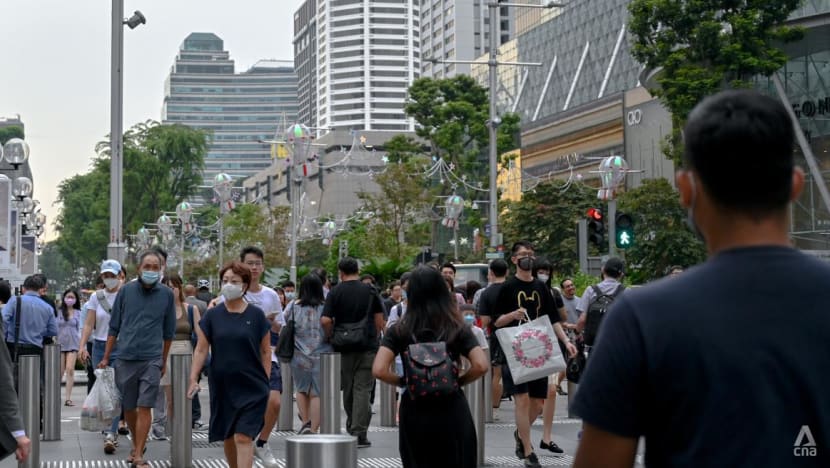Snap Insight: Where is Singapore headed in its new post-COVID-19 norm?
Although we wish for no similar pandemic again, Singapore's experience with COVID-19 shows that the people of Singapore will pitch in to protect one another, says the NUS Saw Swee Hock School of Public Health’s Alex Cook.

File photo of people crossing the road in Orchard Road in Singapore on Oct 19, 2022. (Photo: CNA/Hanidah Amin)
SINGAPORE: Three years and two days ago, Singapore raised its alert level for the COVID-19 outbreak to code orange. Hours later, long queues started appearing at supermarkets across the island, with residents stocking up on necessities in case of a lockdown.
That lockdown, or circuit breaker, came two months later on Apr 3, 2020. Most workplaces were closed and schools went into home-based learning mode. Residents were advised to remain home and avoid socialising with others. Masks became mandatory soon after.
On Thursday (Feb 9), the COVID-19 multi-ministry task force held its last press conference, announcing an end to three years of restrictions that aimed first to contain the COVID-19 outbreak and then to mitigate its impact.
Singapore will move to DORSCON green on Monday, the lowest alert level since the pandemic started. During the last three years, our lives were restricted and more than 1,700 people died from COVID-19, but both the social and health impacts were much worse in most comparable countries. What, then, are the lessons for future health crises?
LESSONS FOR THE FUTURE
The first striking point is how ready Singaporeans were to take the steps that medical experts and the Government recommended to prevent spread. Mask-wearing in Singapore was not as common before COVID-19 as it was in Japan.
Yet even today when masks are required in only very limited settings, many people continue to wear masks voluntarily. It is to be hoped that the habit becomes ingrained, that people automatically wear a mask whenever they have symptoms of a cough or cold.
Similarly, the acceptance and high uptake of COVID-19 vaccinations in Singapore is impressive in comparison to our international peers. This is a reflection of several factors, from the initial procurement, the well-organised deployment, the fact that vaccines were offered free, outreach efforts and, most importantly, the willingness of so many of us to get vaccinated to protect ourselves and our families.
There are lessons for how we promote vaccination with other life-saving, and cost-effective, vaccines, such as influenza: Should individuals really have to pay for these, when indirect benefits are reaped by society and not merely the person being vaccinated?
And can non-financial barriers to vaccination be addressed as they were with COVID-19 vaccines, such as by the SMS prompt to make an appointment that helps to overcome both inertia and not knowing when and how to get vaccinated?
LESSONS FROM THE PAST
We ought also to take heed of the biggest black mark in Singapore’s response, namely the huge outbreaks in foreign worker dormitories in the early days of the pandemic. The four months during which foreign workers were ringfenced in dormitories in 2020, and the imposition of strict controls on their movement for more than a year thereafter, could be argued as an unfortunate necessity, given the high density in their living conditions and the difficulty in finding alternative arrangements.
Now that we are moving to DORSCON green, we must not forget that their living conditions leave them highly vulnerable to outbreaks (which in turn exposes the resident population to risk of contagion) and move forward with steps to improve their quality of life.
The most important lesson, though, has been that through the efforts of every one of us - we wore our masks, worked from home, tested ourselves regularly, limited our social gatherings, as we were asked to - we were able to keep the death rate to less than 10 per cent of that in countries of comparable wealth, such as the United States and the United Kingdom.
Instead of the 1,700 deaths we’ve had so far, we could easily have seen 17,000. Lots of us would have known someone who died of COVID-19. Although we wish for no similar pandemic again, it is a given that new viruses will continue to emerge and threaten humanity.
Despite this, the experience of the last three years has shown that if, or when, there is another pandemic like COVID-19, or for other catastrophes like the climate crisis, we can have confidence in the people of Singapore being able to pitch in to protect one another.
Associate Professor Alex Cook is Vice Dean (Research) and Domain Leader (Biostatistics and Modelling) at the Saw Swee Hock School of Public Health, National University of Singapore.


















